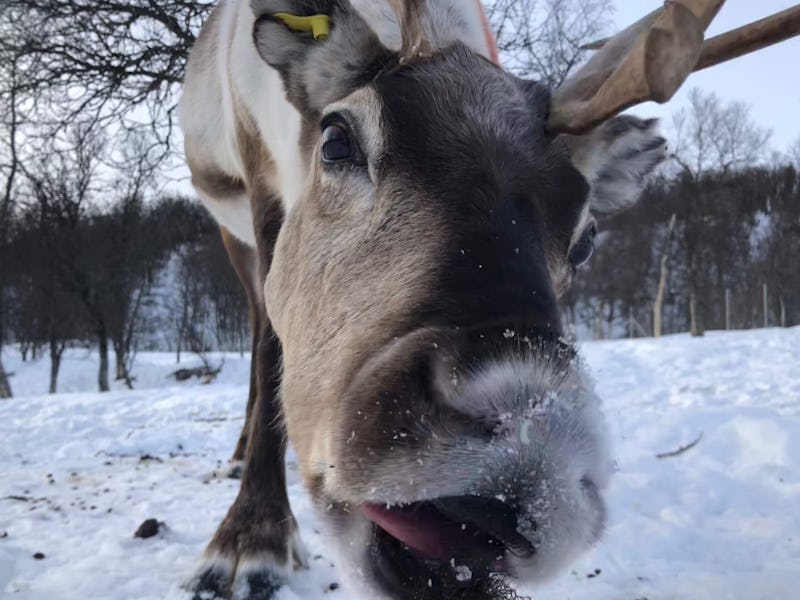Reindeer Have This Bizarre, Innate Trait That Helps Them Sleep Soundly
Rudolph the Red-Nosed Ruminant, more like.

Dasher, Dancer, Prancer, Vixen, Comet, Cupid, Donner, Blitzen, and yes, even Rudolph have evolved an excellent strategy to rest efficiently, a new study finds. Published today in the journal Current Biology, this paper by researchers in Switzerland and Norway gifts us a discovery about how rumination — the process of rechewing partially digested food called cud — rejuvenates reindeer.
Like cows, deer, camels, and llamas, reindeer are ruminants. All ruminants are four-stomached herbivores who feed on rough plants, regurgitate the partially digested cud, then chew it again and swallow. But the new paper, which analyzed the brainwaves of four reindeer during sleep, found that chewing cud may be as instrumental to rest as sleeping.
“Rumination does not only cover digestive, but also sleep needs,” the paper’s first author Melanie Furrer, a neuroscientist and sleep researcher at the Zurich Children’s Hospital, tells Inverse in an email.
Furrer and her team examined data from reindeer at the animal facility at The Arctic University of Norway in Tromsø. Using non-invasive electroencephalography (EEG) on these creatures, the team observed that the reindeer’s brainwaves changed when they were sleeping, ruminating, or functioning while sleep-deprived.
The team found that within a 24-hour period, these reindeer spent, on average, 0.9 hours in rapid-eye movement (REM) stage sleep, 5.4 hours in non-REM sleep, and 2.9 hours ruminating. The EEG’s significance pertains to the brainwave patterns picked up during non-REM sleep and rumination; the two patterns were similar. This resemblance indicates that rumination could serve as a sort of rest period.
The researchers also deprived these reindeer of sleep for 2 hours to see how a deficit would impact their sleep following deprivation. While reindeer appeared to sleep more deeply after these 2 hours (indicated by slow-wave activity in the EEG), rumination changed this outcome. When reindeer ruminated, the more slow-wave activity decreased, suggesting that their sleep deficit wasn’t as severe. In other words, rumination could help reindeer catch up on much-needed rest.
The team was also curious about how external environmental factors affected their sleep. Light affects all creatures’ wake-sleep cycle in a set of behaviors known as circadian rhythm. However, reindeer terrain like Tromsø is unusual because the summer months have essentially 24 hours of sunlight, and the winter months have 24 hours of darkness. By experimenting in a light-controlled room (with unlimited food), the researchers simulated the same hours of light and dark as there are on the autumn equinox, summer solstice, and winter solstice. Regardless of light conditions, the reindeer slept the same amount.
This demonstrates that “reindeer sleep requirements are tightly regulated by the brain and not the environment,” Furrer writes. “They do not change the amount they sleep across the year even though they are more active in summer and less in winter.” She and her team also found that reindeer generally sleep more at night than during the day in autumn, but lack a 24-hour rhythm in summer and winter when light is constant.
So if you ever get concerned that Santa’s fleet is overworked, know that all the time they spend ruminating while flying through the air helps them get through to Christmas morning.